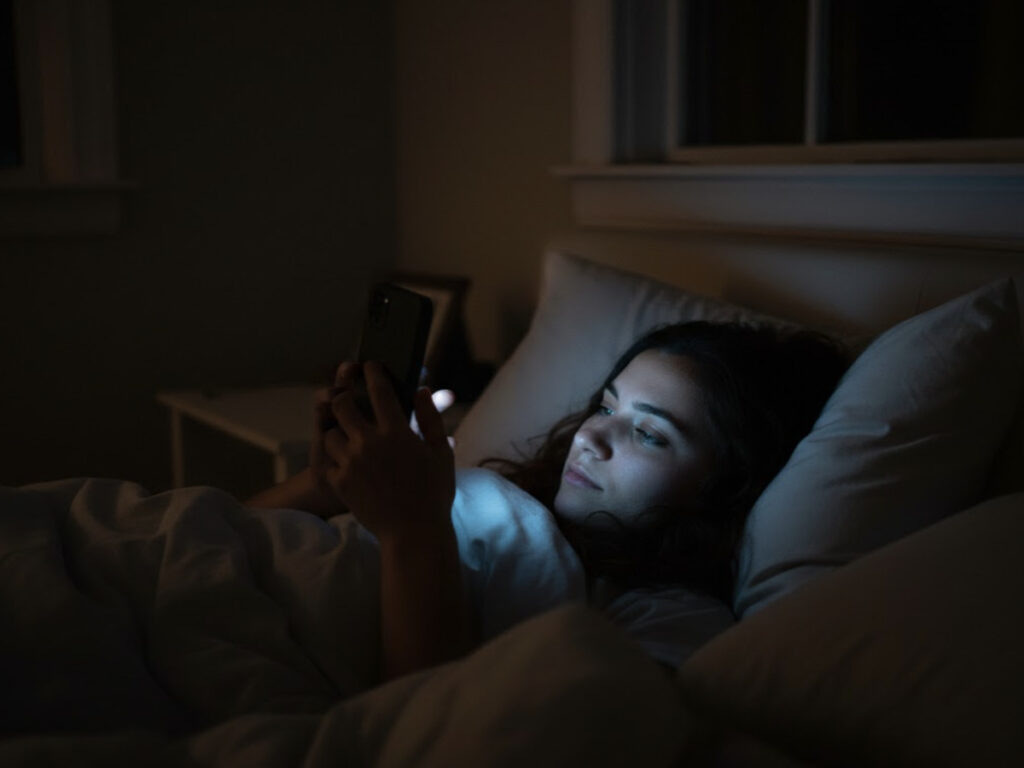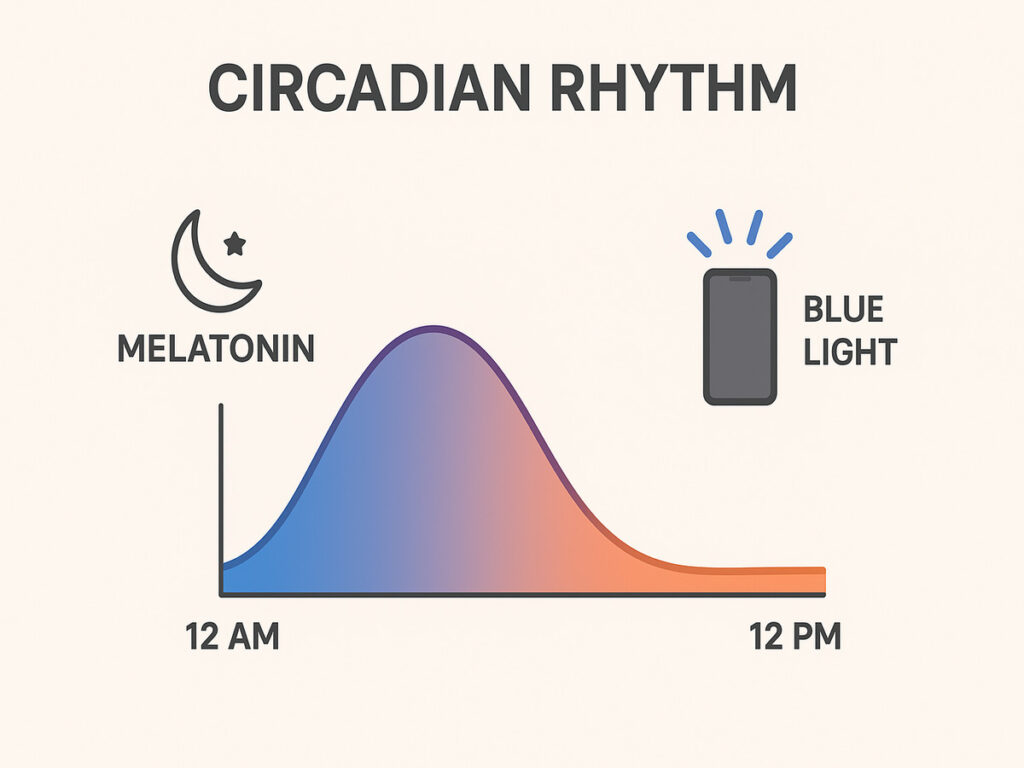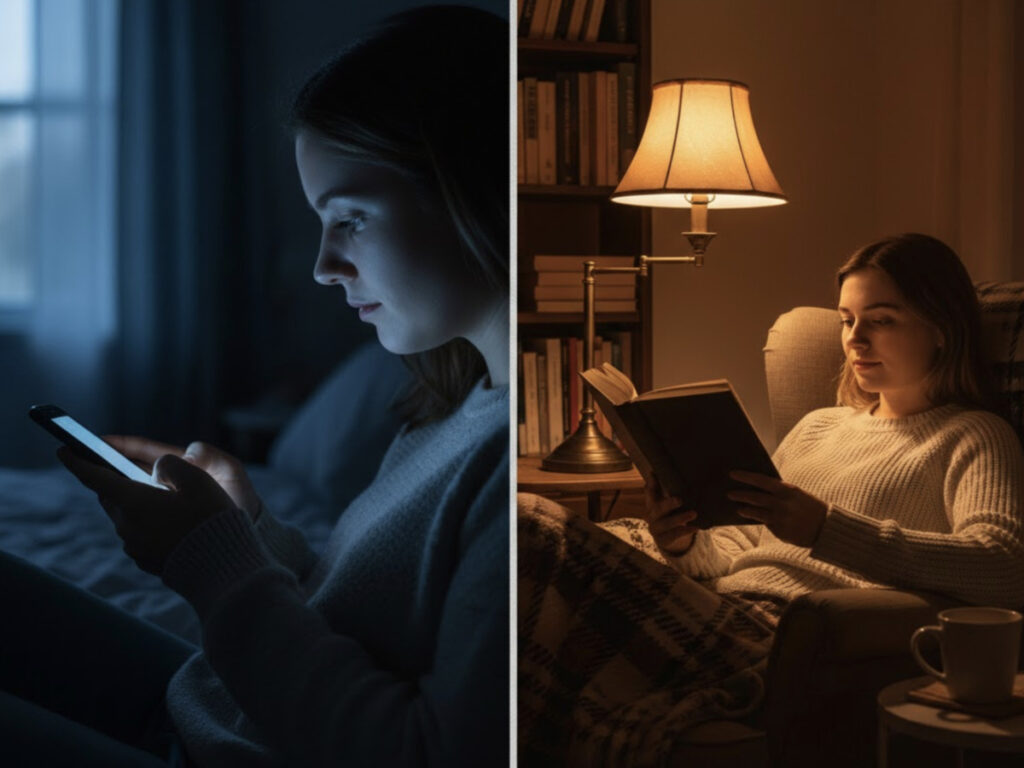Introduction: The Hidden Epidemic of Blue Light Insomnia
Blue light insomnia has become one of the most overlooked sleep disruptors of modern life. As Americans spend an average of seven hours daily on screens, exposure to artificial blue light—especially during the evening—can significantly delay sleep onset, suppress melatonin production, and reduce overall sleep quality.
Research from the American Academy of Sleep Medicine (AASM) shows that exposure to blue light after 9 p.m. delays the body’s natural sleep rhythm by up to 90 minutes, affecting alertness, mood, and hormonal balance the following day.

What Is Blue Light and How It Affects the Brain
Blue light is a high-energy visible (HEV) wavelength, between 400–490 nanometers, emitted by digital screens (phones, tablets, laptops, TVs), LED lighting, and even energy-efficient bulbs.
While daytime exposure to blue light enhances alertness and cognitive function, evening exposure confuses the brain into thinking it’s still daylight. This reduces melatonin synthesis—the key sleep hormone—and activates cortisol, the “wake-up” hormone.
Statistic: The Harvard Medical School Sleep Division found that blue light suppresses melatonin twice as much as other wavelengths and shifts circadian rhythms by approximately three hours.
The Science of Sleep Hormones: Melatonin and Cortisol
Your body’s internal clock, or circadian rhythm, relies on the natural light-dark cycle to regulate two critical hormones:
- Melatonin: Signals the body that it’s time to sleep. Levels rise after sunset and peak around midnight.
- Cortisol: Keeps you awake and alert during the day, naturally tapering off in the evening.
When exposed to screens before bedtime, melatonin drops, cortisol spikes—and the brain stays in a wakeful state, delaying REM cycles and reducing deep sleep.
How Evening Screen Use Disrupts Your Circadian Rhythm
Blue light exposure in the evening sends mixed signals to your suprachiasmatic nucleus (SCN)—the brain’s circadian control center. The SCN regulates hormone secretion, body temperature, and metabolism.
This disruption can lead to:
- Delayed sleep phase syndrome
- Reduced sleep duration and quality
- Daytime fatigue and irritability
- Long-term risk of metabolic disorders

The Real-World Health Impacts of Blue Light Exposure
Over time, chronic blue light exposure can contribute to more than poor sleep. Studies link nighttime screen use to:
- Metabolic disturbances (insulin resistance, weight gain)
- Mood disorders (depression, anxiety, cognitive decline)
- Eye strain and retinal stress (digital eye syndrome)
- Reduced immune resilience
A 2024 Stanford Sleep Research Center study found that adults exposed to blue light for more than two hours before bedtime had 40% higher risk of poor sleep efficiency and 30% increased morning fatigue compared to those using blue-light filters.
Expert Insights on Digital Sleep Disruption
“Your brain’s sleep clock is incredibly sensitive to light cues. Blue light exposure after sunset tells your body it’s still daytime—so your sleep hormones stay off balance,”
— Dr. Evelyn Ross, MD, Neurologist, Sleep Science Institute
“Most people think scrolling before bed relaxes them. In reality, it’s activating the visual cortex and delaying deep sleep by up to two hours,”
— Dr. Thomas Heller, Clinical Psychologist, National Sleep Foundation
Strategies to Protect Sleep Hormones and Restore Balance
1. Implement Digital Curfew: Avoid screens at least 60–90 minutes before bed.
2. Use Blue Light Filters: Enable “Night Shift” or “Eye Comfort Shield” on devices.
3. Switch to Warm Lighting: Use amber or red bulbs post-sunset.
4. Optimize Bedroom Environment: Keep it dark, cool, and free from electronic glow.
5. Use Blue Light Blocking Glasses: Choose lenses with verified HEV filtration.
6. Practice Screen-Free Wind-Down: Read a paperback, stretch, or meditate.

Actionable Checklist for Blue Light Management
| Task | Frequency | Benefit |
|---|---|---|
| Enable night mode on all devices | Daily | Reduces HEV exposure |
| Set digital curfew 1 hour before sleep | Nightly | Improves melatonin production |
| Use amber reading lights | Nightly | Protects circadian rhythm |
| Take screen breaks every 20 mins | Daily | Reduces eye strain |
| Limit LED light after sunset | Daily | Promotes natural hormone cycle |
Comparison Table: Blue Light Sources and Mitigation Methods
| Source | Intensity | Risk Level | Best Mitigation |
|---|---|---|---|
| Smartphones | High | Severe | Night mode, blue-light glasses |
| LED Bulbs | Moderate | Medium | Warm-colored LEDs |
| Laptop Screens | High | Severe | Filter apps, brightness control |
| TV Screens | Moderate | Medium | Dim lighting, distance viewing |
Common Myths & FAQs
Q1: Can I just dim my screen to reduce blue light?
A: No. Brightness reduction helps minimally—blue light filters are essential.
Q2: Is blue light harmful during the day?
A: No. Daytime exposure supports alertness. The issue is timing, not blue light itself.
Q3: Are all blue-light glasses effective?
A: Choose glasses that block 400–490 nm wavelengths with lab certification.
Q4: How long does it take to fix blue light insomnia?
A: Most users notice improved sleep within 7–14 days after consistent nighttime reduction.
Authoritative Resources
- Harvard Health Publishing – Blue Light Has a Dark Side
- National Sleep Foundation – Light and Sleep
- Sleep Health Journal – Screen Use and Sleep Health
Other Interesting Articles
- Caffeine Tolerance Reset: How to Restore Energy Sensitivity Without Quitting Coffee
- Glucose Spikes After Healthy Meals: Why It Happens and How to Fix It
Conclusion & Call-to-Action
Blue light insomnia isn’t just a sleep issue—it’s a lifestyle signal imbalance. By adopting digital hygiene and light discipline, you can restore your circadian health, improve mood, and awaken truly refreshed.
Next step: Begin a 7-day “Digital Sunset Challenge.” No screens 90 minutes before bed. Track your sleep quality—and experience what real rest feels like.

